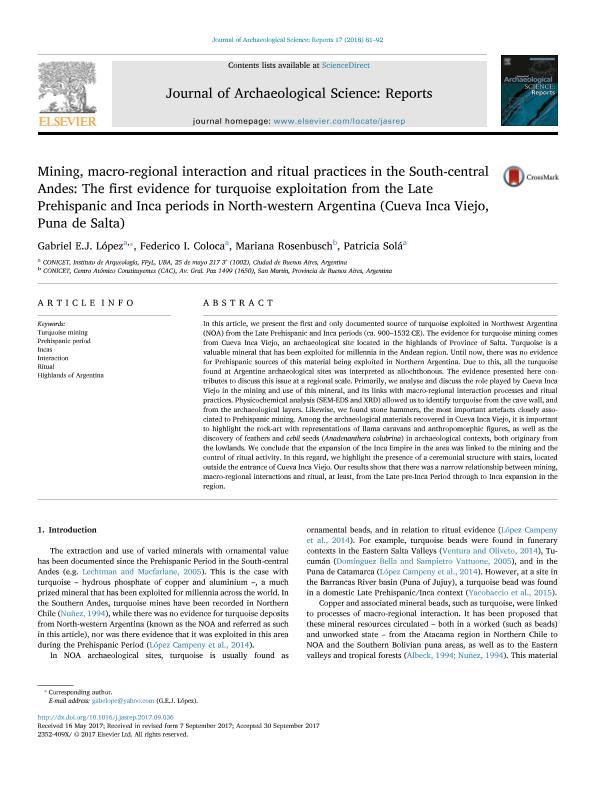Mostrar el registro sencillo del ítem
dc.contributor.author
Lopez, Gabriel Eduardo Jose

dc.contributor.author
Coloca, Federico Ignacio

dc.contributor.author
Rosenbusch, Mariana Lidia

dc.contributor.author
Sola, Patricia

dc.date.available
2021-07-06T17:55:08Z
dc.date.issued
2018-02
dc.identifier.citation
Lopez, Gabriel Eduardo Jose; Coloca, Federico Ignacio; Rosenbusch, Mariana Lidia; Sola, Patricia; Mining, macro-regional interaction and ritual practices in the South-central Andes: The first evidence for turquoise exploitation from the Late Prehispanic and Inca periods in North-western Argentina (Cueva Inca Viejo, Puna de Salta); Elsevier; Journal of Archaeological Science: Reports; 17; 2-2018; 81-92
dc.identifier.issn
2352-409X
dc.identifier.uri
http://hdl.handle.net/11336/135580
dc.description.abstract
In this article, we present the first and only documented source of turquoise exploited in Northwest Argentina (NOA) from the Late Prehispanic and Inca periods (ca. 900–1532 CE). The evidence for turquoise mining comes from Cueva Inca Viejo, an archaeological site located in the highlands of Province of Salta. Turquoise is a valuable mineral that has been exploited for millennia in the Andean region. Until now, there was no evidence for Prehispanic sources of this material being exploited in Northern Argentina. Due to this, all the turquoise found at Argentine archaeological sites was interpreted as allochthonous. The evidence presented here contributes to discuss this issue at a regional scale. Primarily, we analyse and discuss the role played by Cueva Inca Viejo in the mining and use of this mineral, and its links with macro-regional interaction processes and ritual practices. Physicochemical analysis (SEM-EDS and XRD) allowed us to identify turquoise from the cave wall, and from the archaeological layers. Likewise, we found stone hammers, the most important artefacts closely associated to Prehispanic mining. Among the archaeological materials recovered in Cueva Inca Viejo, it is important to highlight the rock-art with representations of llama caravans and anthropomorphic figures, as well as the discovery of feathers and cebil seeds (Anadenanthera colubrina) in archaeological contexts, both originary from the lowlands. We conclude that the expansion of the Inca Empire in the area was linked to the mining and the control of ritual activity. In this regard, we highlight the presence of a ceremonial structure with stairs, located outside the entrance of Cueva Inca Viejo. Our results show that there was a narrow relationship between mining, macro-regional interactions and ritual, at least, from the Late pre-Inca Period through to Inca expansion in the region.
dc.format
application/pdf
dc.language.iso
eng
dc.publisher
Elsevier

dc.rights
info:eu-repo/semantics/openAccess
dc.rights.uri
https://creativecommons.org/licenses/by-nc-sa/2.5/ar/
dc.subject
HIGHLANDS OF ARGENTINA
dc.subject
INCAS
dc.subject
INTERACTION
dc.subject
PREHISPANIC PERIOD
dc.subject
RITUAL
dc.subject
TURQUOISE MINING
dc.subject.classification
Arqueología

dc.subject.classification
Historia y Arqueología

dc.subject.classification
HUMANIDADES

dc.title
Mining, macro-regional interaction and ritual practices in the South-central Andes: The first evidence for turquoise exploitation from the Late Prehispanic and Inca periods in North-western Argentina (Cueva Inca Viejo, Puna de Salta)
dc.type
info:eu-repo/semantics/article
dc.type
info:ar-repo/semantics/artículo
dc.type
info:eu-repo/semantics/publishedVersion
dc.date.updated
2021-07-05T14:36:00Z
dc.journal.volume
17
dc.journal.pagination
81-92
dc.journal.pais
Reino Unido

dc.description.fil
Fil: Lopez, Gabriel Eduardo Jose. Universidad de Buenos Aires. Facultad de Filosofía y Letras. Instituto de Arqueología; Argentina. Consejo Nacional de Investigaciones Científicas y Técnicas; Argentina
dc.description.fil
Fil: Coloca, Federico Ignacio. Universidad de Buenos Aires. Facultad de Filosofía y Letras. Instituto de Arqueología; Argentina. Consejo Nacional de Investigaciones Científicas y Técnicas; Argentina
dc.description.fil
Fil: Rosenbusch, Mariana Lidia. Comisión Nacional de Energía Atómica. Centro Atómico Constituyentes; Argentina. Consejo Nacional de Investigaciones Científicas y Técnicas; Argentina
dc.description.fil
Fil: Sola, Patricia. Universidad de Buenos Aires. Facultad de Filosofía y Letras. Instituto de Arqueología; Argentina. Consejo Nacional de Investigaciones Científicas y Técnicas; Argentina
dc.journal.title
Journal of Archaeological Science: Reports
dc.relation.alternativeid
info:eu-repo/semantics/altIdentifier/doi/https://doi.org/10.1016/j.jasrep.2017.09.036
dc.relation.alternativeid
info:eu-repo/semantics/altIdentifier/url/https://www.sciencedirect.com/science/article/pii/S2352409X17303589
Archivos asociados
